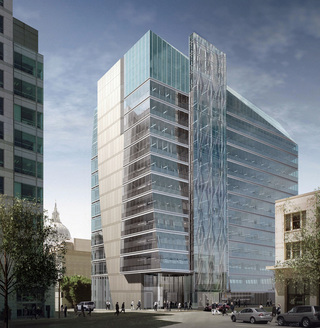
Surveys
DJC.COM
December 11, 2008
Making green design deliver ROI, not just LEED
KMD Architects

Huang
|
The pressure of a sliding economy is forcing building sponsors to revisit plans for new construction, but this sharpened-pencil atmosphere needn’t automatically doom the interest in creating green, sustainable facilities.
To the contrary, sustainable design is gaining ground because it can be more efficient, cost effective and a corporate differentiator that delivers return-on-investment. In fact, the recent romance with green-measurement tools such as LEED, or the BuiltGreen ratings for Seattle-area housing from the Master Builders Association, should not overshadow the most important rating — ROI.
In our work designing green and sustainable facilities throughout the world, the ROI benefits are often the most compelling reason to create forward-thinking offices, schools, housing, retail space, hospitals and research facilities.
Developers, corporations and architects need to re-cast the discussion of green design in terms of cost-savings, productivity gains and other tangible corporate benefits. Here are three core principles of sustainability, viewed from the lens of ROI:
1. The company can save on energy costs, and avoid rising energy costs that old facilities face.

Image courtesy of KMD Architects The 250,000-square-foot Public Utilities Commission building in San Francisco was designed with sustainable elements. Now in development, it will have thermal shafts, photovoltaic panels, demountable partitions and materials salvaged from the site’s existing building. |
Buildings account for 65 percent of total electricity consumption, a third of all greenhouse gas emissions, and almost 1.5 million tons of construction and demolition waste in the U.S., according to the World Business Council for Sustainable Development. Researchers show that new facilities use far less energy than existing buildings. At the new Pacific Northwest National Labs research buildings in Richland, raised-floor systems, advanced window glazing and design, plus a shared public lobby joining two once-distinct departments cut energy costs significantly over current uses.
2. The company can improve profits with employee productivity gains and reduced absenteeism.
An oft-overlooked principle of a building’s sustainability is employee productivity and human performance. For example, more than a dozen research studies cited in the Oct. 19, 2004, Wall Street Journal document how daylighting has contributed to the decrease in absenteeism, improved worker productivity and higher retention. In one study, absenteeism was 2 percent lower for workers in environments with adequate daylight. Projecting this 2 percent savings over a typical 30- to 50-year operation of a new building, tenants and developers easily recoup the initial investment in enhanced daylighting.
In San Francisco, the city’s Public Utilities Commission announced plans for a new headquarters building that will capture both resource-conservation and human-productivity benefits. Not only would its high-rise in the Civic Center complex reduce energy and water consumption, but its design that includes strategic placement of windows and light-bouncing techniques would bring significant daylighting into interior workspaces.
3. The company can recruit more competitively, improve retention, and differentiate against competitors.
Dozens of companies have enhanced their corporate brand by embracing sustainably designed offices and other green practices. There are tangible benefits to such a burnished image: Significantly stronger recruiting success, better employee retention, and an extra layer of differentiation against competitors, in most any industry.
The Great Lakes Brewing Co., maker of Fat Tire beers, has achieved strong differentiation from its corporate sustainability efforts including its major production facility in Colorado sporting energy, water and other resource-efficient characteristics.
The 901 Fifth Ave. building in Seattle, the former Union Bank building completed in 1973, recently achieved LEED-EB (existing building) silver certification, a rare accomplishment compared to LEED designations given to new buildings. As one of the largest environmental retrofits for an existing property and Seattle’s first full city block attaining LEED certification, 901 Fifth takes a distinct new image in the marketplace and becomes a more formidable leasing choice.
Even Seattle City Hall is in on the act, demonstrating local leadership and national differentiation. Mayor Greg Nickels’ proposed Green Building Capital would attain 20 percent improvement in the energy efficiency of homes and businesses, both new and existing, as a way of reducing the city’s overall greenhouse gas emissions by 80 percent before 2050. The program would not only reduce emissions and save energy, but create green-collar jobs as well.
As with the PNNL, city of San Francisco and city of Seattle examples, governmental bodies are often better able to take the lead because of their return-on-investment horizon is longer than the private sector. These efforts demonstrate that sustainability has a broader, long-term financial impact than simply cutting next-month’s energy costs or attaining a LEED certification label.
Green buildings are becoming a standard in the industry today, but it is important for project sponsors and industry participants to focus as much on the real results as on the labels.
Sean Huang is a design principal with KMD Architects in Seattle. KMD has five offices in the U.S., Mexico and Asia. Notable KMD designs include the Seoul City Hall in Seoul, Korea; Two Rodeo Drive in Beverly Hills, Calif.; Nadya Park in Nagoya, Japan; Brigham & Women’s Hospital in Massachusetts; The Cleveland Arcade in Cleveland; Ford Field in Detroit; and Jie Fang Headquarters in Shanghai, China.
Other Stories:
- CBA speakers take on the economy
- A green future for savvy developers
- Market District evolves as a walkable neighborhood
- Mixed-use projects can pay off handsomely
- Local retailers will fare better than others
- Suburban hubs will draw tomorrow’s renters
- Seattle’s office market: No more high-fiving
- Industrial market hums along, but don’t hold your breath
- CBA ready to mint a new breed of green brokers
- Weathering the storm
- Young guns take their shot at the market
- David A. Sabey
Sabey Corp. - Sean G. Hyatt
Trammell Crow Residential - Lynn Michaelis
Weyerhaeuser Co. - Dan Ivanoff
Schnitzer West - Commercial real estate prepares for the future
- The pitfalls of renting out condo projects
Copyright ©2009 Seattle Daily Journal and DJC.COM.
Comments? Questions? Contact us.